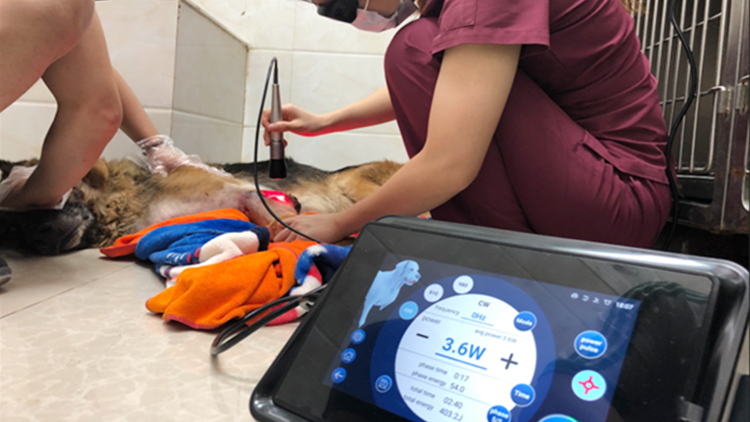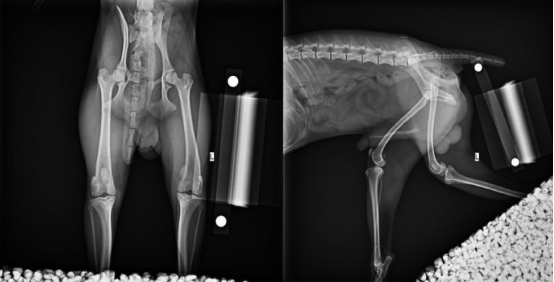
2023-05-23 3013
Abstract
Patella dislocation is a common clinical disease in pets, accounting for 7% of all genetic diseases, which is a very high number. At the onset of the disease, the canine patella can not be located in the normal anatomical position in the trochlear groove, which affects the stretching and motor function of the knee joint, resulting in different degrees of walking dysfunction, manifested as claudication of the affected limb, and even paralysis. In this case, diagnostic evaluation was carried out according to clinical symptoms, scientific examination combined with X-ray, and a surgical treatment plan was formulated. The postoperative physiotherapy with Lunvet veterinary laser has achieved a good treatment effect, which is reported as follows.
Key words: laser treatment, laser therapy , canine bilateral patella surgery
1. Case presentation
NAME:Max
GENDER: Male
AGE: 1
WEIGHT: 3KG
2. Examination

3.Diagnosis
Combined with palpation, blood routine, hemagglutination, biochemical and X-ray examination, the affected canine was diagnosed with bilateral patella dislocation grade 3.
4.Treatment
4.1 Bilateral trochlear groove deepening surgery + postoperative conventional medication + laser therapy
4.2Treatment
Drug: Cefazoline + meloxyl look
Operation: 7 days anti-inflammatory drugs and 5 days painkillers
Laser therapy: Canine-musculoskeletal-knee-light-1-7kg
Probe selection: 25mm non-contact probe
Irradiation method: non-contact irradiation, 1cm of skin irradiation
Number of treatment: the total number of 6 times, first for 3 consecutive days, the next 3 times once the next day
4.3 Treatment process
|
2022.12.7 The first day of laser physical therapy after the surgery |
|
2022.12.9 Third day of laser treatment
|
|
2022.12.14 Seventh day of laser therapy |
|
2022.12.15 Eighth day after rehabilitation with laser therapy
|
5. Summary
Max had the symptoms of claudication before surgery, which is a more serious condition. He walked slightly on the first day beyond our expectations. Laser therapy in this treatment plays a considerable auxiliary role, it can reduce pain and promote tissue repair, accelerate the recovery after the operation, the dog's mental appetite is very good, the eighth day of the wound wound healing well, discharged smoothly, the owner was very satisfied.
6. Discuss
01. Introduction of the patellar dislocation
Patellar dislocation is a common joint disease in small pets. It is one of the most common orthopedic congenital malformations in canine and is rarely seen in feline. The incidence rate is 7%, with the highest proportion of all genetic diseases. The dislocation of patella occurs in bilateral hind limbs, causing physical discomfort and loss of function.
Most of the medial patellar dislocation is related to skeletal muscle abnormalities, such as internal migration of quadriceps muscle group, remote external rotation of femur, femoral shaft dysplasia, knee rotation instability, and tibial deformation. The deformation of the bones and abnormal muscles cause the patella not to exert pressure on the trochlea, which leads to the failure to obtain the normal depth. According to the bone case degree of patellar dislocation, it is divided into the following four levels:
The grade 1 patella was dislocated by external forces, but the patella returned to its normal position and the joint flexion and extension were normal.
Grade 2 femoral torsion is slightly deformed and the patella is dislocated during an artificial external force or flexion of the knee, but only returns to its normal position with the external force.
Grade 3 patella is dislocated most of the time, and can only be manually restored when the knee extends, but after the external force disappears, the patella is dislocated. At this level, the quadriceps group is displaced, abnormal knee support tissue, and femur and tibia deformation.
The level 4 proximal tibial plateau has 80-90 degrees of rotation, the patella dislocation cannot be reduced by external force, the trochlear groove becomes superficial or disappeared, and the femorotibia is usually more severe.
02.Traditional treatment methods
As expected, patellar dislocation generally requires surgical treatment, medical treatment rarely corrects the dislocation, and it is generally believed that patellar dislocation does not undergo surgery when causing any clinical symptoms. Dislocations are at grade 2 and above and often require surgery.
One week after the operation, antibiotics, oral joint painkillers, and local wound disinfection every day.7~10 days to removal. Exercise was limited for 2 weeks after surgery, and then moved in a small area. After 1 month, it basically returned to normal, but activities such as jumping sofa should be avoided.
03. Advantages of laser therapy
Laser therapy played a surprising effect in this case, by stimulating the release of endogenous endorphin and enkephalin, thereby inhibiting the conduction of A δ and C fibers [1] regulate serotonin (aka serotonin / 5-HT) content [2] reduce bradykinin [3] regulating acetylcholine content [4] to relieve postoperative pain, make the affected dog can walk after surgery.
At the same time, laser therapy can also improve the local blood circulation, improve the level of cell metabolism, and effectively reduce the swelling caused by inflammation. The terminase cytochrome C oxidase that promotes the cellular respiratory chain accelerates ATP production, thereby promoting the regeneration and healing of damaged tissues.[1] Make the affected dog recover well on the eighth day after the operation, and the wound can be removed normally.
Laser therapy can also stimulate bone morphogen protein (BMP) activity, to regulate the osteoblast activity, secrete more collagen matrix, [5] so laser therapy can help orthopaedic bone tissue healing faster after the eighth day after the dog gait back to a better state, let pet master more trust the ability of doctors and hospitals.
Reference:
[1] Progress in the therapeutic mechanism and clinical application of high-energy laser therapy in pain diseases Liu Yao, Fang Ming, Chen Liping, Shen Chinese Journal of Pain Medicine 2020,26 (12)
[2] Animal pain recognition and evaluation research progress far away, Xiong Huijun, Jia Kun Tang, Wang Heng, Sun Ling, Sun Shuang, Sun Yao Han Taiguang, Li Shoujun Animal Husbandry and Veterinary Journal 2014,45 (10): 1592-1599
[3] Bradykinin, ion channels and inflammatory pain Liu Boyi, Zhang Hailin Pharmaceutical Journal Acta Pharmaceutica Sinica 2009,44 (10): 10661071
[4] Acetylcholine: the first original neurotransmitter discovered in humans: ACh brain housekeeping
[5]《Veterinary Laser therapy in Small Animal Practice》María Suárez Redondo DVM PhD CVA